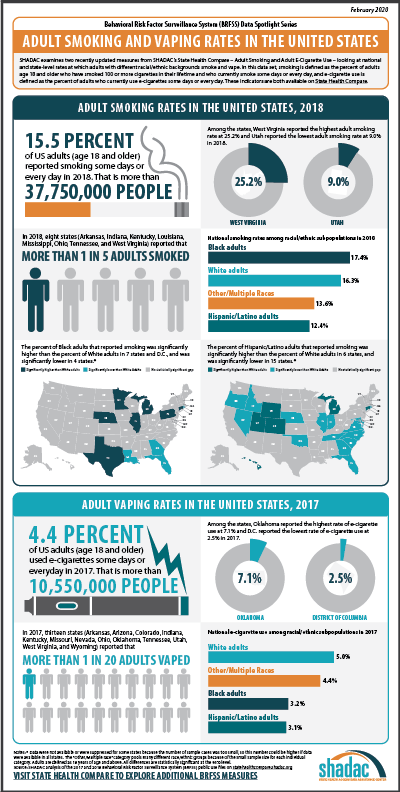Percent of adults who have smoked 100 or more cigarettes in their lifetime and who currently smoke some days or every day
Measure Overview
Despite successes of widespread information campaigns and policy measures to prevent and reduce tobacco use, millions of U.S. adults continue to smoke tobacco cigarettes. Smoking causes a number of diseases such as lung cancer, stroke, and diabetes, and increases the risk of tuberculosis, rheumatoid arthritis, and other adverse health conditions. Ongoing surveillance of adult smoking rates in the U.S. is a critical step in identifying populations more prone to smoking and can help inform efforts to eradicate smoking altogether.
State Health Compare presents annual, state-level rates of adults who smoke traditional tobacco cigarettes based on findings from the Behavioral Risk Factor Surveillance System (BRFSS). These rates can be broken down by education level (less than high school, high school graduate, some college/associate’s degree, or bachelor’s degree or higher) and race/ethnicity (White, Hispanic/Latino, African-American/Black, Asian/Pacific Islander, or Other/Multiple Races). BRFSS defines smoking as individuals who smoked 100 or more cigarettes in their lifetime and who currently smoke some days or every day.
State Health Compare presents annual, state-level rates of adults who smoke traditional tobacco cigarettes based on findings from the Behavioral Risk Factor Surveillance System (BRFSS). These rates can be broken down by education level (less than high school, high school graduate, some college/associate’s degree, or bachelor’s degree or higher) and race/ethnicity (White, Hispanic/Latino, African-American/Black, Asian/Pacific Islander, or Other/Multiple Races). BRFSS defines smoking as individuals who smoked 100 or more cigarettes in their lifetime and who currently smoke some days or every day.
Generate customized graphics using this data by selecting one of the options below.
Related Products

BRFSS Spotlight Infographic Series: Adult Smoking and E-Cigarette Use in the United States
This infographic examines national and state-level rates at which adults with different racial/ethnic backgrounds use traditional cigarettes and e-cigarettes (also known as “vapes”). Analyses and visualizations presented in the infographic are based on findings from the Behavioral Risk Factor Surveillance System (BRFSS) annual telephone survey.
